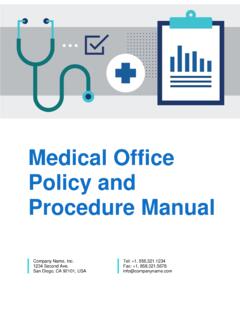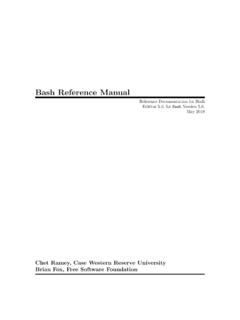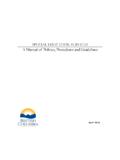Transcription of Chapter 31 What Types of Interventions Do Physical ...
1 1 Chapter 3. 2 What Types of Interventions Do Physical 3 Therapists Provide? 4. 5 Physical therapists provide 2 general Types of Interventions : 6 Patient/client instruction/education. The process of informing, educating, or training 7 patients/clients, families, significant others, and caregivers is intended to promote and 8 optimize patient/client function and occurs in every episode of care. Instruction may be 9 related to the current condition; specific impairments in body function and structure, 10 activity limitations, or participation restrictions; the plan of care; transition to a different 11 role or setting; risk factors for developing a health condition or disability; or need for 12 participation in a health, wellness, or fitness program. 13. 14 Interventions to achieve patient/client goals and expected outcomes. To meet the 15 needs identified through the examination data, the evaluation, the diagnosis and the 16 prognosis, and the goals and expected outcomes for the patient/client, the Physical 17 therapist selects, applies, and modifies Interventions based on their known properties as 18 demonstrated by scientific evidence and properties of Interventions as demonstrated by 19 the Physical therapist's expertise in delivering the Interventions .
2 Based on patient/client 20 response to the Interventions , the Physical therapist may decide that an evaluation is again 21 necessary. This decision may lead to a change in the plan of care, including a change in 22 intervention or changes in frequency or duration or, alternatively, the discontinuation of 23 care or a referral to another practitioner. 1. 24. 25 Data collection occurs at each visit to determine whether the response of the patient/client to the 26 Interventions is as expected. 27. 28 Interventions 29 Airway Clearance Techniques 30. 31 Description 32. 33 Airway clearance techniques are a group of therapeutic activities intended to manage or prevent the 34 consequences of impaired mucociliary transport or the inability to protect the airway (eg, impaired 35 cough). 36. 37 Interventions 38. 39 Airway clearance techniques may include the following: 40. 41 Breathing strategies 42 o Active cycle of breathing or forced expiratory techniques 43 o Assisted cough/huff techniques 44 o Autogenic drainage 45 o Paced breathing 46 o Pursed lip breathing 47 o Techniques to maximize ventilation (eg, maximum inspiratory hold, staircase breathing, 48 manual hyperinflation).
3 49 Manual/mechanical techniques 50 o Assistive devices 51 o Chest percussion, vibration, and shaking maneuver (rib springing). 52 o Chest wall manipulation 53 o Incentive insprirometer 54 o Suctioning 55 o Ventilatory aids 56 Positioning 57 o Positioning to alter work of breathing 58 o Positioning to maximize ventilation and perfusion 59 o Pulmonary postural drainage 2. 60 Scenarios 61. 62 The following scenarios are not intended to fully describe the Interventions that would be used for each 63 patient/client. The scenarios are narrowly focused to illustrate the Airway Clearance and Techniques . 64 category and are not intended to be inclusive of all Interventions that would be performed in clinical 65 practice. Interventions from a number of categories would likely be used in actual practice. 66. 67 A 6-year-old girl with cystic fibrosis has been admitted to the pediatric unit with acute pseudomonas 68 pneumonia. The Physical therapist may use positioning for pulmonary drainage, chest percussion, 69 vibration, shaking maneuver (rib springing), and assisted cough techniques.
4 The caregivers and 70 parents/guardians also are instructed in the techniques. 71. 72 A 12-month-old girl with spastic quadriparesis is being seen by an early intervention team at home. 73 She lifts her head for 1 or 2 seconds in the prone position. Her parents also express concerns about 74 stiffness and difficulty handling when feeding. She has had poor oral motor control since birth, has 75 difficulty with thin liquids, and eats only pureed foods. Her parents are employed, and her mother 76 works out of the home. The parents' goals are for her to eat regular foods, walk, and attend nursery 77 school. Based on the results of the evaluation, the Physical therapist may educate the parents in 78 suctioning and other manual techniques for airway clearance to help their daughter avoid aspiration. 79. 80 A 24-year-old man with tetraplegia at the C3 level, who is ventilator dependent, is preparing for 81 discharge to a home environment.
5 He needs an assessment of his home environment, 82 recommendations for home modifications, assistive devices, and training for himself and his personal 83 care assistant. The Physical therapist may instruct the personal care assistant in positioning to alter 84 work of breathing and in the use of suctioning equipment. 85. 86 A 55-year-old woman has chronic obstructive pulmonary disease (COPD) and a history of 2. 87 hospitalizations in the past 2 or 3 years due to pulmonary infections. She quit smoking 2 days ago. 88 She is referred to an outpatient pulmonary rehabilitation program to address activity limitations due to 89 dyspnea. She is overweight and prefers to support her forearms on the thighs in sitting. The Physical 90 therapist may use autogenic drainage and active cycle of breathing techniques to assist in the 91 clearance of mucus, which is one of the causes of airway obstruction in people with COPD, in 92 addition to providing instruction in sitting posture to maximize the ease of breathing.
6 93. 3. 94 Assistive Products and Technologies 95 Description 96. 97 Assistive products and technologies are products, instruments, equipment, and technologies adapted or 98 specifically designed for improving the function of a disabled person. 99. 100 Interventions 101. 102 Assistive products and technologies may include the following: 103. 104 Aids for locomotion (eg, crutches, canes, walkers, rollators, manual wheelchairs, power 105 wheelchairs, power-operated vehicles). 106 Assistive products and technologies to improve safety, function, and independence (transfer 107 technologies, such as transfer boards and mechanical lifts/hoists; bathroom technologies, such as 108 raised toilet commode, adaptive commodes, transfer benches, sliders; activities of daily living 109 [ADL] technologies, such as eating and dressing assists). 110 Orthoses (eg, ankle-foot orthoses, knee-ankle-foot orthoses, body jackets, wrist cock-up splints, 111 shoe inserts).
7 112 Prostheses (eg, transtibial and transfemoral prostheses, upper-extremity prostheses). 113 Seating and positioning technologies (eg, custom-molded seating, removable lateral trunk 114 supports, and upper-extremity support trays for wheelchair; sidelyers; prone standers, manual or 115 power recline systems for wheelchair). 116. 117 Scenarios 118. 119 Scenarios for the Assisted Products and Technologies category are incorporated into the scenarios for 120 the Functional Training category. 121. 122. 123. 4. 124 Functional Control (Stability and Mobility). 125. 126 Functional control and functional training are 2 categories of intervention promoting the performance of 127 functional activities. Functional control refers to planned Physical movements, postures, or activities 128 intended to enable the patient/client to perform and enhance functional activities. Functional training, 129 covered in the next section, uses functional control and activities in training for self-care; domestic life.
8 130 work (job/school/play); and community, social, and civic life. 131. 132 Interventions 133. 134 Functional control Interventions may include the following: 135. 136 Balance training 137 Developmental activities training 138 Gait and locomotion training 139 o Developmental activities training 140 o Gait training on various terrains and dual task 141 o Implement and device training 142 o Perceptual training 143 o Standardized, programmatic, and complementary exercise approaches 144 o Manual and power mobility training 145 Motor function (motor control and motor learning) training or retraining 146 Neuromuscular education or reeducation 147 Perceptual training 148 Sensory training or retraining 149 Skeletal alignment/posture training 150 o Body mechanics and postural stabilization 151 o Body mechanics training 152 o Postural control training 153 o Postural stabilization activities 154 o Posture awareness training 155 Standardized, programmatic, and complementary exercise approaches 156 Vestibular training, including canalith repositioning/habituation exercises 157.
9 158. 159 Scenarios 160. 161 The following scenarios are not intended to fully describe the Interventions that would be used for each 162 patient/client. The scenarios are narrowly focused to illustrate the Functional Control category and 5. 163 are not intended to be inclusive of all Interventions that would be performed in clinical practice. 164 Interventions from a number of categories would likely be used in actual practice. 165. 166 A 50-year-old man who had a left-sided cerebrovascular accident (CVA) after surgery for an aortic 167 valve replacement 30 days ago is able to isolate movement against gravity and resistance but has 168 difficulty moving quickly or changing direction of movement. He has difficulty balancing on one leg 169 in order to put on his pants while standing and loses his balance when turning rapidly and when 170 stepping over objects. He is able to walk independently on smooth, level surfaces; however, he loses 171 his balance on elevations and uneven surfaces.
10 He uses a cane when in the community. The Physical 172 therapist may use general and task-specific balance exercises for motor retaining to address his 173 balance during mobility. 174. 175 A college football player has recurrent ankle injuries that he reports occur during backwards running. 176 The Physical therapist may use motor control and perceptual training in addition to task-specific 177 performance training and may use injury prevention education to allow the patient/client to continue 178 competing without ankle injuries. 179. 180 An 82-year-old man with a 10-year history of Parkinson disease has demonstrated a functional 181 decline over the past 3 months, including decreased balance. His goal is to improve mobility in order 182 to lessen the caregiver burden on his wife. The Physical therapist may focus on posture and balance 183 awareness training and balance training along with a plan for mobility. 184. 185 A 70-year-old woman sustained a right-sided CVA 12 weeks ago.




